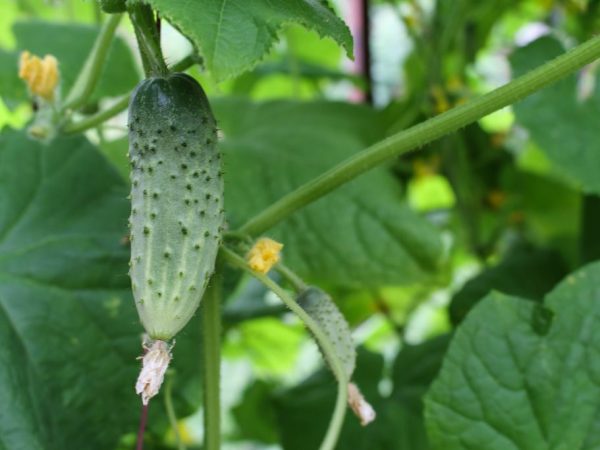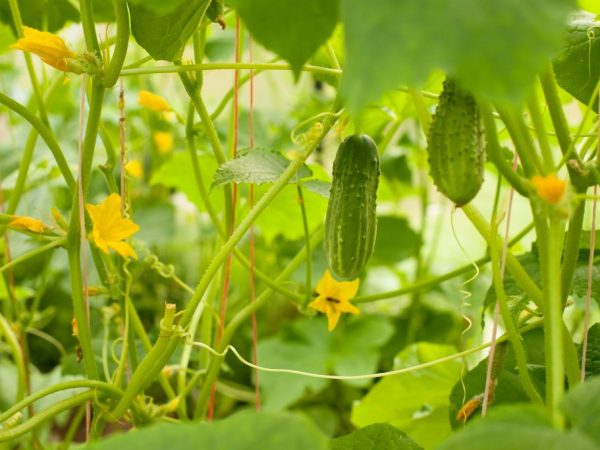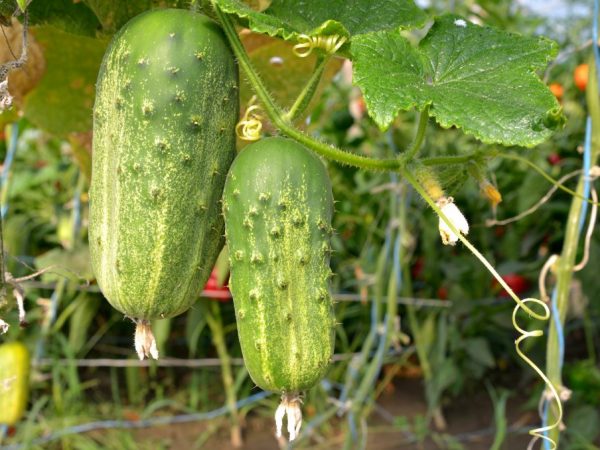Popular varieties of cucumbers with the letter F
Cucumber varieties with the letter F are common in the modern market. We can say that it is with her that most of the varieties of culture begin. Gardeners who grow cucumbers in their summer cottages try to give preference only to hybrid varieties of the F1 category, because they are more resistant to diseases and parasites. In addition, hybrids are characterized by high yield rates. Consider all varieties of cucumbers that begin with the letter F.

Popular varieties of cucumbers with the letter F
Farmer
Cucumber Farmer belongs to indeterminate crops. The growing season from the moment of planting the seeds to the beginning of the formation of fruits is about 45 days, although the ripening time is more dependent on climatic conditions: in warm regions of the country, Farmer f1 cucumbers ripen for 37 days, in cool regions there may be a slight delay of 5 days. This is a bee-pollinated hybrid, so it is grown in open field conditions. The leaves are rather large and wide in structure.
According to the description, the surface of the Farmer variety cucumber is even, but with small, sparse ribbed areas. On it you can see a small number of bumps covered with white pollen. On average, the length of a single ripe fruit is 14 cm. The pulp is juicy and sweet.
Farmer's cucumbers are suitable not only for fresh consumption, but also for making salads or preserving. The yield is 9 kg per 1 sq. m.
Features of the
Farmer cucumbers are planted only by the seedling method. This makes it possible to increase the resistance of the variety to negative environmental conditions, but the fruit ripens a few weeks later. Planting cucumber seeds Farmer f1 is carried out only when the soil warms up to a temperature of 16 ° C. If the temperature is lower, it is difficult for the seeds to germinate.
Place 2 seeds in each well. This increases the germination rate. As soon as the first shoots appear, the site is thinned out. 1 plant is removed from each well, leaving only the best specimens. The distance between the rows should be about 30 cm, and between the holes - 50 cm. Frequent planting leads to the fact that the plants are constantly deficient in oxygen in the soil and nutrients.
If you are going to plant using seedlings, then the seeds are planted in containers 30 days before the intended planting in open ground. It is not recommended to transplant seedlings quickly, because planting in unprepared or poor-quality soil reduces yield indicators. Seedlings are planted only after the soil temperature reaches 17 ° C.
If the weather conditions do not allow planting, but the seedlings are already fully formed, you can slow down their growth. To do this, slightly lower the temperature of the room where it is located.
Care features
Cucumbers Farmer needs quality care.Despite the exactingness in care, all activities are simple and do not take much time to carry out. It is important to pay attention to the required actions.
- Watering. Plants are rarely watered. The watering interval should be about 3-4 days. Watering is carried out only with water at room temperature, otherwise the root system will not be able to assimilate it.
- Top dressing is carried out using minerals and organic preparations. At the time of the formation of inflorescences and fruits, the plants are fed with mineral preparations containing potassium and nitrogen. After the beginning of fruiting, fertilizing with humus is carried out so that the bush forms new fruits faster.
- The crop is harvested as the fruit ripens. If you wait even a little with this action, the yield will decrease by 2 times.
Diseases and parasites
Cucumber Farmer f1 is characterized by excellent indicators of the immune system. According to the description, it is resistant to diseases such as powdery mildew, stem spot or leaf mosaic. To protect the variety from other fungal diseases, preventive measures are taken.
The bush is regularly sprayed with milk whey. The optimal processing interval is 10 days. If there is no serum, they use a solution of water and milk, and also use medicinal preparations such as Oxyhom.
Fugue

Fugue cucumber will delight you with an early harvest
The Fuga grade of category F1 is in the State Register of the Russian Federation. The variety is suitable for growing in all regions of the country, regardless of climatic conditions. The variety ripens in a short amount of time. The growing season is about 40 days.
The bush is low, no more than 50 cm. The leaves are small in structure and have a rich green tint.
The fruits of the variety are quite large. Their length is 12-15 cm, cross-sectional diameter is 5 cm. The surface is smooth, without pronounced tubercles. The taste is rich, sweet, without bitterness. The variety is suitable for fresh consumption or for preparing salads. Yield indicators are 12 kg per 1 sq. m.
Growing
It is recommended to grow a variety of Fugue cucumbers using the seedling method. Seeds for seedlings are planted 30-40 days before the intended planting in open ground. Seeds do not have to be disinfected and treated with growth stimulants. The manufacturing company has already taken care of all the preparatory steps.
Seeds are planted in separate containers, since the species does not tolerate the picking process poorly, as a result, the root system may be disrupted. The soil is chosen only nutritious, with good air permeability. Sand is added to loamy soil in a ratio of 3: 1. Chernozem or sandy soils do not require processing.
Transplanting into open ground is carried out when several pairs of leaves have formed on the seedlings and the soil has warmed up to a temperature of 15 ° C. A distance of 40 cm is kept between the rows, and 50 cm between the holes.
Care features
Caring for the Fuga variety is simple and does not require any special agricultural skills.
- Watering. It should only be carried out with warm water. Plants are watered every 4 days. It is advisable to water at the root so that moisture does not get on the leaves.
- Top dressing. Top dressing is carried out with mineral and organic substances, depending on the age of the bush. Young bushes are fed only with mineral compounds, as they contribute to the proper formation of the bush, while adult plants at the fruiting stage are fed with organic matter (humus or bird droppings).
- Weeding and loosening. Do not forget about removing weeds, loosening the soil and regular garters, because the root system needs a constant amount of nutrients. If a crust forms on the surface of the earth or weeds appear, the root system will be deficient in nutrients. The garter allows the bush to maintain its appearance and not deform from the weight of large fruits.
Diseases and parasites
The Fugue variety has high immunity rates. It is not susceptible to diseases such as mosaic, gladosporium or powdery mildew.
Prevention is carried out against parasites. To do this, weeds are regularly removed, because it is on them that spider mites or aphids are located. You also need to remember about regularly spraying the bushes with drugs such as Araks or Confidor.
Philippok

The variety is only suitable for greenhouses
F1 Filippok is suitable for growing in all regions of the country, it should only be planted in greenhouse conditions. The growing season is 50 days. The bushes are characterized by a female flowering type and indeterminacy. Plant height does not exceed 60 cm. The foliage is medium-sized, rich green.
The fruits are small, their average length is 12 cm. There are excellent yield indicators. From sq. m collect about 10 kg of selected products. Sweet fruits are suitable both for fresh consumption and for making salads or preservation for the winter.
Growing features
The variety is grown both as a seedling method and using seeds. It is only important that all seeds for planting go through the process of disinfection and treatment with growth stimulants. This reduces the risk of disease and speeds up the ripening process.
Planting is carried out only in warm soil. The optimum soil temperature is not lower than 15 ° С. It is important to remember the correct spacing when planting seeds. The distance between the rows should be 30 cm, and between the holes - 40 cm.If transplanting seedlings, you need to adhere to the 40 x 50 cm scheme.
Care
Caring for this variety is simple and does not require much time or effort. First of all, high-quality watering is important. It is carried out once a week and only with warm water. It is best to use a drip irrigation system to keep moisture out of the leaves. The next important step is feeding. They are carried out only with minerals containing potassium and phosphorus. This allows the root system to take root better in the ground and improves fruiting performance.
It is important to regularly loosen the soil and remove all weeds. These conditions are necessary to reduce the risk of root rot, because a crust on the surface of the soil will prevent air from reaching the roots, and constant watering will lead to rot and deformation of the roots.
Parasites and diseases
This type of cucumber is characterized by excellent indicators of the immune system. The bush is not affected by diseases such as powdery mildew, spotting, fruit rot or late blight, but the variety is not immune from the effects of parasites.

The plant is resistant to diseases
Prevention against parasites includes high-quality care measures. With a large number of weeds, Colorado beetles or spider mites appear; they will have to be dealt with with drugs such as Confidor or Oxyhom.
Style
The Fason variety is included in the State Register of the Russian Federation and is suitable for growing in the central and southern parts of the country. The culture is planted only in open ground, since it is a bee-pollinated variety. The bushes are indeterminate, with a female flowering type. The height of the bush is 50 cm. The leaves are small, dark green.
The fruits are small. The length of one is 10 cm, and the weight does not exceed 60 g. The surface of the fruit is smooth, without roughness and bumps. The taste is sweet, without bitterness. The variety is suitable for making salads, canning or fresh consumption. The yield is 7 kg per 1 sq. m.
Planting and growing
Planting is carried out only with the help of seedlings. To begin with, the seeds are treated with a manganese solution to kill all negative trace elements and bacteria. The seeds are then planted in separate containers to reduce the risk of damage during the pick. The best germination of seeds is observed at a temperature of 20 ° C and good illumination.
As soon as the first pair of leaves appears on the plant, they are planted in open ground. In this case, it is important that the soil warms up to 17 ° C. They keep a distance of 40 cm between the rows, and 50 cm between the bushes.
Care
Care for this species is standard.
- Watering is carried out every 3 days and only with warm water. For watering, choose the evening or morning time so that moisture does not evaporate from the sun's rays.
- Top dressing is carried out 3 times during the entire growing season. Potassium or magnesium is used 10 days after planting. After 3 weeks, the plants are fertilized with phosphorus, and humus is introduced at the time of ripening.
- Loosening the soil and removing weeds are necessary for the supply of nutrients and oxygen to the roots.
Despite the fact that the Style is characterized by excellent immunity, it is necessary to carry out preventive measures in time: constantly inspect the plant for the presence of parasites. Secondly, you should properly look after the garden so that diseases cannot develop.
Pharaoh
Pharaoh, belongs to the bee-pollinated species, so the planting is carried out in the open field. The growing season is 50 days. The bushes are characterized by vigor and medium size. The height of the bush is 75 cm.
The fruits are large, dense. The length of an individual fruit is 16 cm and the diameter is 5 cm. The surface of the fruit is smooth, without pronounced tubercles or ribbed areas. Fruit color is deep green. The taste is sweet, with a small amount of acid. No bitterness is observed. The yield is 14 kg per 1 sq. m.
Growing
The cultivation is carried out using seeds. In early May, when the soil warms up to a temperature of 15 ° C, planting is carried out. It is best to throw 2 seeds into each hole. This will increase the likelihood of uniform seed germination.
If both seeds gave a plant, only more developed seedlings should be left. There is a distance of 50 cm between the rows, and 60 cm between the holes.
Care
Care consists in high-quality watering, fertilizing, loosening the soil and removing weeds. Watering is carried out 2 times a week with warm water and only in the morning.
Top dressing is carried out twice during the growing season:
- during the formation of inflorescences, potassium substances are introduced.
- during fruiting with the use of humus.
Remove weeds and loosen the soil the next day after irrigation is set. This allows moisture not to stay in the ground, as a result, the root system receives more oxygen and nutrients. It is also important to remember about tying the bush, because the formation of the fruit leads to its deformation.
Pharaoh's f1 category is resistant to diseases and parasites, so regular spraying is not necessary. To protect the plant from pests (Colorado potato beetle or aphids), you just need to regularly remove the weeds and plant the crop away from vectors of the disease (peppers or potatoes).
Conclusion
Cucumbers, whose name begins with the letter F, almost all belong to hybrid crops, therefore, they are characterized by higher yields and resistance to most diseases. Planting and caring for the crop should be done correctly in order to reap a good harvest.


